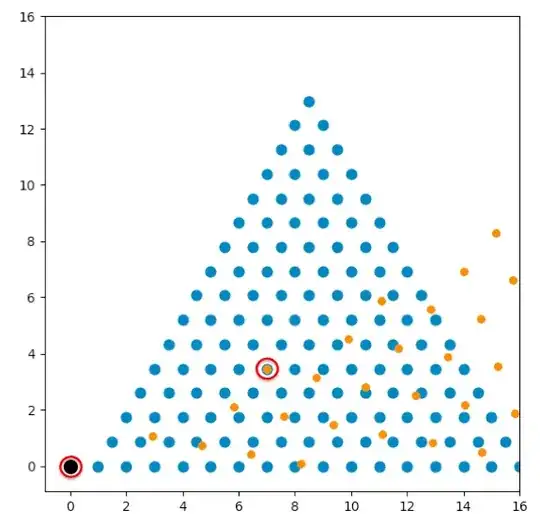My earlier question How should I restrict the points considered in each hexagonal lattice to correctly count all unique near-coincident lattices? turns out to have an excellent and instructive answer, primarily because I'd left out part of the question I'd planned on posting.
Please see How should I restrict the points considered in each hexagonal lattice to correctly count all unique near-coincident lattices? for the setup to this question, but now with the added constraint that the absolute values of the indices $(i, j), (k, l)$ will be limited to some finite size with a parameter $n_{max}$ such that $|i| \le n_{max}$, $|j| \le n_{max}$ and $|i+j| \le n_{max}$ which forms a hexagonally bound array of points when $x = a \left(i + \frac{1}{2} j\right)$ and $y = a \frac{\sqrt{3}}{2} j$.
A further constraint for my problem is that $a_2/a_1$ is irrational and fixed. This is the reason for the finite $\delta$. For a small $n_{max}$ there are usually no solutions, but opening up $\delta$ to say 0.01 allows for some near-coincident lattice matchings; we're essentially stretching or compressing the 2nd lattice to "make it coincident" with the first.
Question: How should I restrict the points considered in each hexagonal lattice to correctly count all unique near-coincident lattices when $(i, j)$ are limited by $n_{max}$ as described above?
I know I should restrict my search to a pie-shaped segment of all points in each of the two lattices, perhaps a 30° slice of one against a 60° slice of the other, but I haven't been able to convince myself that this guess is mathematically sound.
Example of a proper coincident lattice: $(i, j), (k, l) = (5, 4), (2, 3)$ with $\frac{a_2}{a_1} = \sqrt{\frac{61}{19}}$ and $n_{max} = 16$ with cuts at $0 \le \theta_{ij} < 60°$ and $0 \le \theta_{kl} < 30°$. This finds exactly one coincidence point. Are these angle restrictions correct to find all near-coincident solutions? Ignoring solutions with lowest common denominators $LCD(i, j, k, l) > 1$ will help avoid some redundancies.

